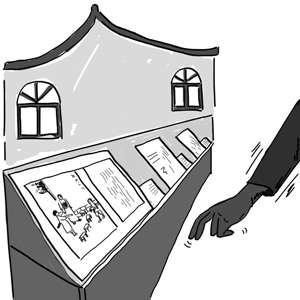Private museums need assistance

Illustration: Chen Xia/GT
Local media reported last week that the private museum in Huangpu district dedicated to Feng Zikai, the famous Chinese cartoonist, essayist and educator, found that visitors had stolen items from its valuable collection, which I think reflects many problems with the operation of private museums, such as a lack of financial input, professional staff and government support.
Staff members at the museum found that three books and a piece of calligraphy were missing from the third floor of the museum located in a three-floor villa at 39 Shaanxi Road South.
The three books belong to a collection of Feng's cartoons called Protection for Living Beings, which was published in the 1930s. The calligraphy was done by Feng's daughter Feng Yiyin.
The museum has suffered numerous thefts since it opened in March 2010. It used to have six books of the most recent version of Protection for Living Beings displayed on a table for visitors to leaf through. All of the books and even the bookmarks in the books were stolen.
The museum staff did not take the previous thefts seriously, but this time, the missing collections are of great value to the museum. Though the value of those works totals more than 1,000 yuan ($163), which is not a large sum of money, the irreplaceable items cannot be found on the open market.
The staff has put up a notice about the missing items in the museum, hoping that they will be returned.
Feng died in 1975. His surviving relatives bought the second and third floor of the villa, which used to be Feng's home in Shanghai, and opened a museum to display Feng's works, hoping to educate the public about Feng's life and work. He is considered "the father of Chinese cartoons."
The museum is open to the public for free from 10 am to 4:30 pm from Wednesday to Sunday. Feng's relatives take turns to staff the museum. There are only one or two staffers on duty at a given time, while the museum receives 260 visitors every day at most. It has received 30,000 visitors since it opened.
There is no surveillance camera in the museum, making it relatively easy for visitors to conduct thefts.
I think this reflects the financial difficulty that many private museums face. Since many private museums are free of charge, they do not have the funds to install facilities or employ more staff members.
It is reasonable for private museums to seek help from the government. The government had helped Feng's family to transform his former residence into the current museum. Since 2011, the Shanghai Municipal Administration of Cultural Heritage maintains a fund of 10 million yuan to support private museums. But generally, large private museums like the Shanghai Museum of Glass get assistance first.
However, we should not put the entire burden on the shoulders of the government. Companies can offer financial help to private museums, which gives them the chance to advertise themselves.
This case also demonstrates that many private museums lack professional staff and management experience. The missing valuable books were put on the third floor, but staff don't usually follow visitors onto that floor. The museum should have better arranged their exhibits and put the valuable pieces under supervision on the lower floor.
Managers at public museums should share their expertise with private museums to help them to be more professional.
Students majoring in museum management should volunteer in private museums, which will help them to practice what they have learned at university.
Also, the museum can open a store selling copies of Feng's works, which can increase income to the museum so that security measures can be strengthened.